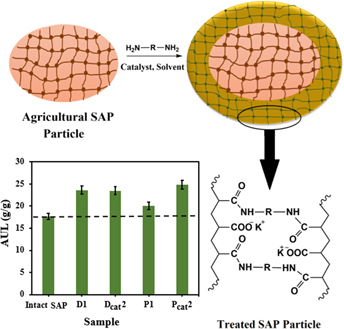Article contents
Transamidation: A feasible approach of surface modification to improve absorbency under load of agricultural superabsorbent materials
Published online by Cambridge University Press: 28 August 2018
Abstract

This research introduces a novel single-step approach to improve the absorbency under load (AUL) of agricultural superabsorbent polymers (SAPs) made of acrylamide. Crosslinked (acrylamide–potassium acrylate–acrylic acid) terpolymers were successfully prepared and modified via a transamidation (amide exchange) reaction. The surface of the polymer particles was treated using polyamine modifiers (i.e., diethylenetriamine and polyethyleneimine) in the presence or absence of AlCl3 as a catalyst. The modification reaction was confirmed via spectral, morphological, and rheological studies. The process variables including time and temperature, the modifier type and amount, and the catalyst concentration were found to affect the polymer swelling properties. The swelling capacity of the control and treated SAPs were determined in deionized water and saline. The AUL in saline, as a key swelling property of SAPs, was also determined. The AUL of the PEI-treated samples (19.82–24.8 g/g) was higher than those of the control (17.7 g/g) and the DETA-treated SAPs (18.3–23.5 g/g). In conclusion, the transamidation effectively improved the AUL of the terpolymer superabsorbents by about 25%.
- Type
- Article
- Information
- Copyright
- Copyright © Materials Research Society 2018
References
REFERENCES
- 10
- Cited by




